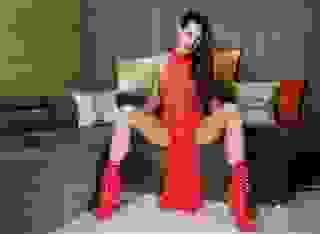- Sci-Fi & Fantasy
- Gabatrix: The Magenta Racer
Note: You can change font size, font face, and turn on dark mode by clicking the "A" icon tab in the Story Info Box.
You can temporarily switch back to a Classic Literotica® experience during our ongoing public Beta testing. Please consider leaving feedback on issues you experience or suggest improvements.
Click hereDisclaimer
Tags: Swearing, Space, Science Fiction, Future, Sex, Group Sex, Love, War, Violence, Blood, Interspecies, Male Human, Female Aliens, Scalie (Shark), Human/Alien Sex, Aggressive Sex, Racing, Intercourse, Impregnate M/F, M/F, M/F, M/FFF
Disclaimer 1: This is a supporting story for the Gabatrix series set just before and mostly after the First Peace. It is highly recommended that you read Gabatrix: Minerva and Gabatrix: The First Peace before getting into this story. This story deals with a war between humanity and an alien race and does contain violence.
Disclaimer 2: This story is meant for adults as it contains sex, violence, cursing, blood, and very light gore (in relation to the violence in one scene only). There is a clear division between the sex and the violence.
Disclaimer 3: This book is an erotica, action, and science fiction rolled into one. Expect scenes of interspecies (Human/Alien Anthro), including pregnancy and group sex. Some scenes may include rough or aggressive sex.
Artwork by Piero Painter.
Special thanks to a fan supporter that wishes to remain anonymous for donating the funds necessary to cover the artwork for the book cover. Thank you very much.
Special Thanks to my Patreon supporters:
Jordy, Mike Nixon, Frank Nordhaus, Nightsound, and Anthony Kestle for their generous donations
Prologue
"Even with space folding technology, I believe that we're still in a perpetual race against time. It is in a race against whatever is out there. It is a race against fate, and it is a race against ourselves. It's up to all of us to pass that finish line together." Gabatrix's comments at the Martian Astrological Research Center, 2320 AD.
....... Humanity and an alien race stand against one another or possibly together. The Itrean clans have set their attention into UWA space.....
.......It is an unknown time period of viable hostility, the possible end of humanity, or a manageable time when there is nothing to fear at all....
.......In orbit of the colony world of Oshun, a UHN serviceman is only a witness to the catastrophic Battle of Oshun. The lingering ailments of war remain within him as he moves forward into the career of racing and the desire to have a family.....
Chapter 1: November 4th, 2349 AD (Prelude)
Space.....the empty blackness devoid of life. In all concepts, that very aspect of it is something that has baffled many lifeforms that are conscious enough to perceive it. It is everything, and it is everywhere.
We stand in the darkness of the great void of nothingness near a far distant yellow dwarf star. We are in the far reaches of the Sol system just past the location of the so-called "Oort Cloud," an area of billions but far-spaced pieces of rocks. The floating debris is often considered to be the entrance and exit barrier to this singular star system. It is vastly enormous, serving as a spherical marker for early human astronomers. Stars twinkle and blink above, below, and in every direction from where we float. The cosmic engine of the galaxy instead keeps us in the perpetual slow orbit as you can see the various colors of the entire light spectrum. It is both beautiful and lonesome to some. Of course, we never had to worry about this as we know where we reside. Space can't hurt us, and instead, we are simply observing the cosmic history of the indigenous life in the universe.
With so much space out there, it can be a massive burden for any developing life that is conscious enough to reach the desire to spread itself. For life such as humans, it had been an evolutionary state of importance. Perhaps it was the same for us as well. Humanity would learn that something was significant in its survival. Speed and intelligence were the keys to its existence. Not only was it smart to develop the tools to hunt and farm, but it was essential to be quick. Being fast was the difference between evading a hunting predator that wanted to eat you and being able to live long enough to reproduce. In our observations of life-like humanity, a similar trend could be observed from time to time.
As humanity continued to evolve, so did the desire to get faster. Earth was a prominent enough place as it was for developing civilizations. The need to get from point A to point B was crucial for governments, societies, economics, and everything to work. Speed is in their heart, even if they agree to it or not.
Such things would often lead us back to here. When humanity reached the stars and began to look to new places beyond Earth, they were suddenly hit with a critical dilemma. Outside of their habitable environment was an utterly enormous barrier that they couldn't exist at all. We can see it for ourselves in the darkness. There is nothing here for them to live in, and even their nearest planets would take months to years to ever get to them. Much of the human race's desire to reach new worlds, they were dashed the moment that they came to this realization.
However, it was not the end to space exploration. Humanity knew that they had a potential enemy that was looming over them. Their planet was becoming more and more hostile towards their existence. A lingering fact had remained that even Earth wouldn't exist forever. Eventually, one way or another, their home would be out of their reach, whether it would take thousands of years or billions of years to achieve it.
It simply came down to one existential factor. Speed was the key to survival. The faster that a spaceship could go, the faster it could reach its destination. We watch as one of the first successful probes of humanity begins to get closer to us. We choose this time and location for a specific reason. We get to marvel at the engineering that this race had created. It is an object that measures about 47 centimeters in height. It isn't that big, having a mass of about 722 kilograms. At the time, it was a marvel of construction when it was launched in their year of 1977. The Voyager probe consists of a container with a dish and radio antenna. On the container are various gadgets, including instruments to measure electromagnetic radiation, solar winds, cameras, and more. It had performed its job admirably, having gathered data on the planets in the outer solar Sol system. As of the time it was launched, the Voyager probes were some of the fastest human-made objects ever made. Traveling at speeds of over 17 kilometers per second, it is never-ending on its journey.
Of course, it still is quite far away from us. The Voyager 1 probe had long completed its mission. Its batteries had been long depleted. It carries one final gift, however. In it is the recordings and data tapes of the human race. It is a time capsule of information and serves as a relic of their existence if something were ever to extinguish them. Even at its incredible speeds, space is so enormous that it took the probe over three hundred years before it reached the Oort Cloud. As it endures its trip, the probe will continue to travel through this region of space for over thirty thousand years. Its destination will take it to what they call the "Ophiuchus Constellation," located almost six light-years away. We watch as the probe zips past us. It is hard to see it completely, but we can note its outlines as it slips further and further away from Earth and beyond.
Humanity had to find something faster than this. The Direct Fusion drive would serve as a method to shave a trip to Mars to a mere few months. Eventually, the vastly improved Super Direct Fusion Drive would reduce the time even further by weeks. Suddenly, distant objects seemed closer, and the human race finally had a method to reach nearby planets. Even if speeds of over 300 kilometers per second seemed quick, it was still too slow. Their nearest star, Proxima Centauri, was over four light-years away. Spaceships would take thousands of years to make that trip, and the humans could only live for so long before their prodigy would have to continue. Like so many space-faring individuals, the humans were trapped until they would fall extinct, discover something else, or invent a new method of propulsion.
We say goodbye to the Sol System. We begin to move away from this area. We go faster and faster until we start to see Sol shrink down to a mere speck amongst the stars. Humanity has grown hungry. Their desire to find something faster than their Super Direct Fusion Drives would propel them to seek any form of faster than light travel ideas and concepts that might provide the answer. Even as we reach lightspeed, you can feel the cosmic phenomenon of the time sheer. What we have been long protected from is a new issue for humankind. As objects reach the speed of light, it is time that begins to operate differently. If we were humans traveling in a spaceship reaching these phenomenal speeds, we would be traveling into the future. What is known as time dilation, these people would experience time progression differently. A year on the ship could be several years back at home. Upon such a realization, the human race was hit with this dilemma as well. Was there a limit to how fast that can you go?
Nothing could reach faster than the speed of light. It is a rule of the cosmos, for the most part. For humanity, there had to be a way to overcome these hurdles. We continue our journey as stars zip past us more and more. The entire scenery changes before us as we now begin to look at a new region of space in the Milky Way Galaxy. We are close to the great center of the galaxy. We can almost see the grand spiral arms of the spinning motion where billions of stars reside. Even before the advent of the fusion drives, humans had been witnessing the natural events that occurred. In 2019 of their calendars, they had found this object that we are closing upon now. It was a remarkable discovery as we began to see a massive trail of lit dust. The matter belonged to something that had reached hypervelocity speeds. It would have required a rather extensive amount of energy to do such a thing, and they were fully aware of it as well.
We reach near the trail as we begin to catch up to this moving object slowly. What is known to them as S5-HVS1 is nothing more than an A-type Dwarf star that has been flung out of the galaxy. Located almost 29,000 light-years from the Sol system, this dying burning ball of gas might have been spared a fated end from the supermassive black hole in the center of the galaxy. It was believed that this star was part of a binary system that was being pulled into the maw of the black hole. One of the dancing stars that spun together watched as its other partner was devoured. Their gravitational hold on each other was broken and tossed into the emptiness of space. S5-HVS1 instead creates a bright cone in front of it as we are parallel with its incredible velocity. The star has reached speeds of over 1,700 kilometers per second. Even if it is less than 1% of the speed of light, the momentum it is moving is incredible. As the white dwarf star bleeds out, it will eventually be left as an empty black husk as it leaves the galaxy entirely into the great voids beyond. Even if humanity knew it would never reach this object anytime soon, it did bring some hope that there were ways to achieve faster and faster velocities.
Eventually, the great gift of Gabatrix would come to fruition. Humanity had finally found a way to reach other worlds. Instead of trying to beat time dilation and breaking the barrier of reaching speeds faster than the speed of light, a new solution had arrived. The ability to fold space safely had been performed. Reverse engineering the fabled alien technology found on Mars would bring forth the new age of exploration, colonization, and salvation for the beleaguered race. But, of course, the very concept of achieving faster speeds and velocities would remain within much of humanity's heart. Perhaps one day, new advancements will allow their vessels and vehicles to progress this ever-growing desire. Folding space is only the beginning.
We say goodbye to the glowing white star of S5-HVS1. It is left to its fate as it sputters away from us. Perhaps one day, some other civilization will see the remains of this object and wonder where it came from. We come to a complete halt as we begin to reverse course back to the inner interior of the Milky Way Galaxy. Once again, the other distant stars begin to zip past us as we reach phenomenal speeds. The stellar matter comes and disappears. The great light of the center of the galaxy vanishes and becomes dark.
You are curious as to the humans right now, aren't you? It was challenging to witness their events after their first peace treaty with the T'rintar clan. Even with the Gabatrix experiment and the success it brought forth, it has raised questions on the continued survival of their species. The "Age of Gabatrix," as the humans termed, is coming to a debatable close. The end of an era of celebration was marked with the inevitable passing of the great pioneer. The descendants of the early explorers have rested and become complacent with their newfound luxuries. There is no name yet for this period of time, a sign that things have become uncertain.
The realization that they had found the former civilizations of the dinosaurs was a shock to all. So was it felt through all the Itrean clans and United Worlds' Alliance. In order for us to continually learn of humanity, we need to delve further into their journey into the cosmos. It is their year of 2349, near the conclusion of a never-ending conflict in which the human race faced utter annihilation against the alien reptilian clans. Colony after colony was beginning to fall. Eutera and Cipra were taken with others teetering on being taken next. It is one month before the alliance with the T'rintar clan.
For now, humanity is on its own as we get closer and closer to our destination. The constellation of Pictor comes into view. The cluster of stars holds one location that we are vested into now. We must hurry as an event is taking place if we are to witness it. Multiple stars fly past us as we near the singular star system. The star we are closing in is a K-Type star. Our journey is sure to take us to this planet again someday. For now, we zoom in on the outermost planet of the star system. Following an elliptical orbit is a planet of interest. Founded by the former unified African governments of Earth is the colony of Oshun.
We slow down as the great blue planet is seen. It is a world that is almost completely covered in water. In the distance are the three small moons that orbit it. In reality, Oshun isn't much of a world to look at from this distance. A water world may seem interesting, but from here, it is simply a blue planet. Of course, there is an activity that is happening on it. There is a viable atmosphere and in the southern equator is a massive spinning cyclone that continues to move in a straight line.
We close in on the world. At this distance, we can faintly see one of the tiny island continents where humanity has settled. Finally, it is here that we can see a series of flashing lights. No.....these are explosions. What we are seeing is something unnatural and artificially made.
It is a battle that is taking place. We have arrived to bear witness to the Battle of Oshun. The humans of this colony are in the fight for their lives. By now, we can see that we are getting to the near end of this conflict. A small Itrean fleet had arrived and brought siege onto the planet. Space debris is everywhere, consisting of destroyed spaceship hulks, vaporized or scorched remains, and perhaps even former living bodies. All of it is floating in the vastness of space. By now, we are so close to Oshun that it takes up a sizeable portion of our view.
The blasts are continuing to occur as we can see seven warships ahead of us. On one side are four UHN Magellan class Battleships. The cylindrical hulls consist of the near rear-mounted spinning centripetal ring, railgun turrets mounted in the mid-dorsal and ventral sides, engine thrusters in the forward and rear, and torpedo tubes in the front. On the other side are three Itrean vessels of unknown design. Their common hull color is that of purple, further illuminated by the distant star of the system.
Two alien vessels are similar in shape and design. They are cylindrical but blockier than the UHN warships. Their hull configuration is almost the same, however. They also consist of engine thrusters in the forward and rear. They have two spinning centripetal rings near the back and have two dual-mounted railguns on the mid-dorsal and ventral sides. The forward section of the hulls is lined with heavy-duty CIWS gatling guns, small missile launchers, and small fin-like protrusions. These two warships are slightly bigger than the Magellan battleships. The other alien warship is significantly smaller. It appears to be a scout ship or support ship of some kind. It consists of a single centripetal ring near the center, large engines on the front and back, smaller guns, and four large tentacle-like protrusions near the aft section. In the front are a fin-like protruding array and a single railgun.
It is an all-out battle. All the ships show signs of damage to various degrees. Blast marks and small fires are clearly seen on the hulls as their internal atmospheres threaten to be vented into space. Missiles are being launched from various areas of Oshun and its moons but are getting shot down by the small CIWS guns of the Itrean warships. The two large alien battleships are moving slowly in a stand-off match of gunfire against the human military. Hypervelocity rounds are fired from their dual-mounted railguns onto the Magellans as the Magellan battleships return fire. The blasts from the guns produce a beautiful blue and purple colorization as the shells are ejected into space. Meanwhile, the single small alien warship is focused on the planet. Its single railgun is firing at the planet's surface as it seems to ignore the larger ships in their dance to destroy one another.
By now, the ships are so close in their fight that it is impossible to avoid the hypervelocity rounds. The Itrean ships are accurate in their shots. One of the UHN battleships takes a direct hit in the mid-section of the vessel by the dual salvos, quickly ripping into its hull and almost punching through to the other side. Meanwhile, the UHN has numbers on its side as one of the warships fires back. Its railgun flies and shatters the top portion of the Itrean battleship in turn. The fin-like protrusion is blown clean off as the shell breaks the supports of the centripetal ring.
It is a fight to the death. There is nothing else in far orbit as both fleets are shrinking in numbers. The great debris behind it is a sign that numerous warships of both sides are getting wiped out. The UHN seems to have the upper hand, but it is still a fierce battle. Tracer fire fills the spectrum as the CIWS guns of the Itrean battleships are shooting down another wave of missiles that are coming their way. The small alien warship continues to fire its small railgun turret towards the southern equator, most likely one of the tiny islands firing its planetary torpedoes towards the alien fleet. Its bow is aimed directly at the planet.
We turn our focus towards the other pair of UHN battleships and one of the Itrean warships. The engines on the ships are off as the ships continue to exchange salvos of railgun fire. There is a successful strike as one of the battleships has managed to score a direct hit on the ventral railgun turret. It shatters the hull area and the components as it blows out into space. However, the dorsal guns answer back as they fire a railgun round in one barrel and a non-hypervelocity nuclear-tipped shell in the other. The speed and trajectory of the shots quickly gain distance between the simultaneous exchange. The alien tungsten round slams into the rear portion of the power generator. Ripping the interior section, the ship suddenly begins to lose power as the armor has been breached. The AIO turrets try to fire a spread of flak bursts towards the nuclear shell, but the loss of power causes the system to seize momentarily. With a burrowed hole in the ship, the nuclear round escapes destruction and enters into the damaged breach.








